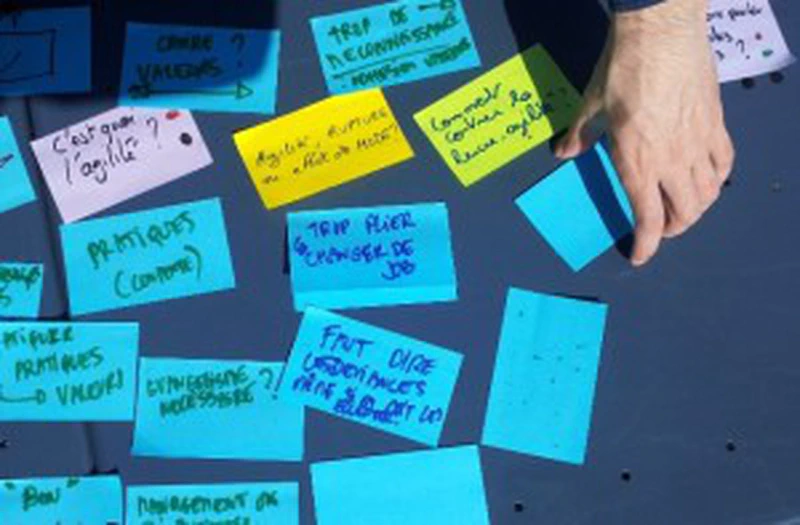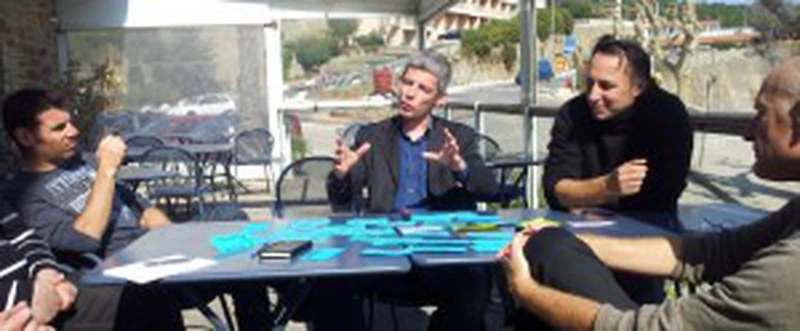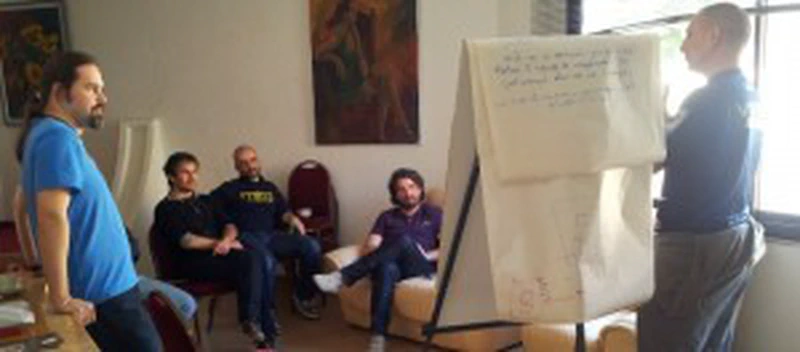Despite a bad cough and antibiotics in my luggage, I had the pleasure of participating in the first edition of Agile Open Sud (#aosud) 2012. Good company (~20 people, but not a single woman… session topic), a pleasant hotel by the sea with very good cuisine (especially the absolutely sublime chocolate mousse/fondant in the evening), interesting topics even though we lacked time to dig deeper into certain points.

Some initial feedback on the activities I was able to participate in:
Are estimates necessary?
Mainly for the dialogue and process they induce. They enable discussion, confrontation (in a peaceful sense), they reveal surprises. They can allow (or push) everyone to express themselves. They validate convergence. They force us to break down, design, envision the work in a finer way. They allow us to project ourselves through planning. But they do not constitute a commitment, and should not be taken literally (well, numerically), nor in isolation (triangulation, comparison).
Scrum & XP are on a boat
A lively discussion around our spirited and amusing debates concerning Scrum & XP. Even though everyone continues to naturally defend their aspirations, we all pretty much agree. Our fight is elsewhere, against the distortion of agile methods. There, nothing more. Some see Scrum as a Trojan horse that allows the introduction of agility, everyone agrees to confirm that even an introduction, or a partial application is better than nothing, a gateway, a starting point. For my part, I particularly enjoy teasing my colleagues on these subjects (they return the favor) because it allows us (even through laughter) a constant questioning, a constant reflection without pain. On this subject, I submit my proposal to change the manifesto: “I prefer working software over a long technical debate”.

Is the scrummaster useless?
Theoretically, self-organization should lead to this conclusion. But then is it motivating to become attached to a role whose objective is to become useless? The scrummaster ensures the application of Scrum, eliminates obstacles, facilitates the work and organization of the team, and protects the team. When all these objectives are achieved, what becomes of them (or when the team is mature enough to do this all by itself)? What do we observe in the field: this is never completely the case (or only with fairly small teams). So it’s quite rare. When this is the case and if possible, the scrummaster can gradually become an agile coach: they take height and distance, they can take a position of facilitator within their organization. They can also oversee multiple teams simultaneously or do more transversal work by teaming up with several Scrummasters. But it’s quite rare (for them to truly become useless). When does this happen? During releases phases. During team re-constitution phases.
To conclude: the scrummaster is (very) useful. Over time they can become much less so, which is the mark of success of their action. But we observe that in the field they disappear very rarely. And it’s difficult to explain to people (ah people…) who want to become scrummaster that the objective is the erasure -partially- of their job.

Skull & Roses
Like “Werewolves of Miller’s Hollow”. We played a game of Skull & Roses, a fun little bluffing game. The game requires lying, being deceitful, trapping all the other participants, lying again, jubilating at another’s failure. In short, a great moment of pleasure that reveals a lot about some people. 2 lessons: you must understand the rule to win, by anti-agile inversion: the game shows the pitfalls of individualism.
Agility, disruption or trend?
Big debate that’s difficult to summarize (hot off the press on Sunday morning at that). I’ll give you some highlights: There is too much ignorance of values, of agile culture. That is to say there is a true schism between the application of practices and the values and principles that are their foundation. However, by applying the practices (without caring about the values) one can arrive at a better understanding of these (values) and finally rediscover them. There is a real boundary between the application of agility without values, without culture and with. We naturally fear that what happened to Lean will happen to agility (a hijacking). We even think it may already be too late, and that the word agility is already lost. To recover it -perhaps- this requires real evangelism, good teaching (we highlight the harm done by certain training around agility, and we also highlight that many “agile” approaches pre-existed for a long time in IT and could have been better supported: through teaching, through training, etc.)
To support our effort, we must also not hesitate to show its alignment with “business” expectations. To summarize with a slightly reductive example: respect for people makes them more effective (so it’s good for business). Or again, the deployment of technical practices supported by agility (continuous integration, tdd, pair programming, etc.) makes applications of better quality (so it’s good for business).
To fight against this distortion: we recommend always clearly stating things: “we should, this is not agile”, etc. But naturally this doesn’t mean we refuse the job or participation: it takes time to acquire all this. So yes we will accompany you and we may not do everything well right away (nor ever, it’s a destination, we tend towards it). But we constantly point out deviations. If, over time, we see it’s not possible to apply agility, we must consider stopping or leaving the mission (but this is at the end of a journey). On the other hand, we must constantly maintain our neutrality, and point out gaps with the target.
There you have it, these are my memories delivered hot, through my prism. Don’t forget the little banjo & guitar session with Olivier. A very pleasant moment.

Only regret: it’s too short. And I didn’t manage to formalize enough the ideas that emerged (I’m not talking about a report, I mean: on site). My opinion: take a real 4-day retreat (in the Cevennes or in Tunisia).
Feedback from Thierry
Feedback from Claude
Feedback from Jean-Baptiste
Feedback from Fabrice
Feedback from Rui
Feedback from Alexis
Feedback from Jérôme